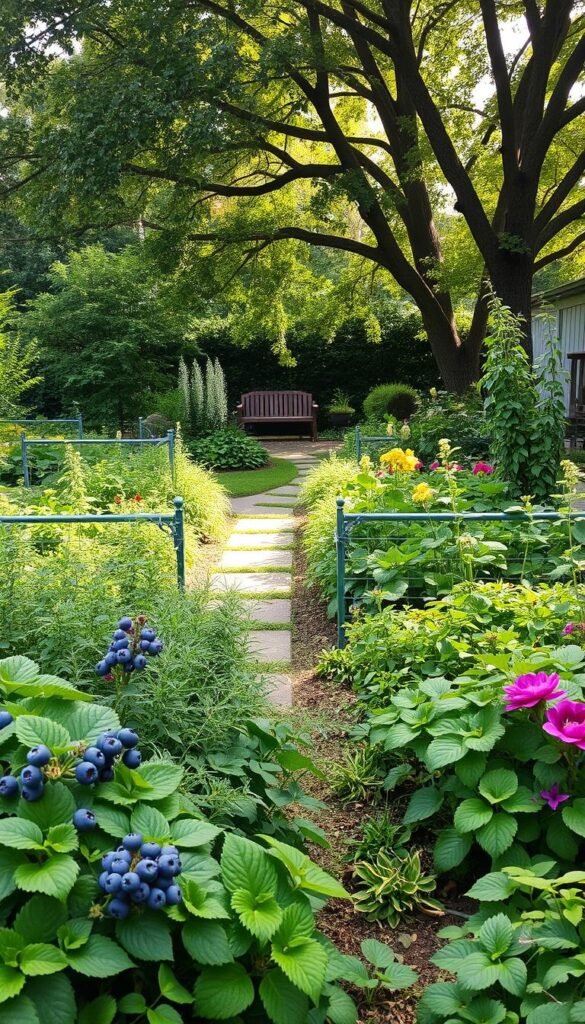Every March, spring fever hits hard. You stare at your empty outdoor space, imagining something more vibrant than just grass and a few seasonal veggies. What if your yard could become a productive paradise bursting with color, texture, and fresh snacks for your family?
Edible landscaping lets you blend beauty with practicality. Instead of dedicating separate areas for flowers and vegetables, you’ll mix food-producing plants with ornamental varieties. Picture blueberries doubling as hedges or apple trees offering shade and autumn harvests. This approach creates visual interest while putting dinner ingredients within arm’s reach.
Starting small makes the process manageable. Focus on perennial options like raspberries or asparagus that come back yearly. You’ll save time and money compared to replanting annuals each spring. Over several seasons, these plants form the backbone of your edible haven, requiring less upkeep as they mature.
Smart planning today means enjoying juicy strawberries by summer and crisp apples in fall. Your space evolves into a living pantry that feeds both your family and local pollinators. Best of all? You’re building a sustainable system that grows more bountiful with each passing year.
Getting Started with Your Edible Landscape
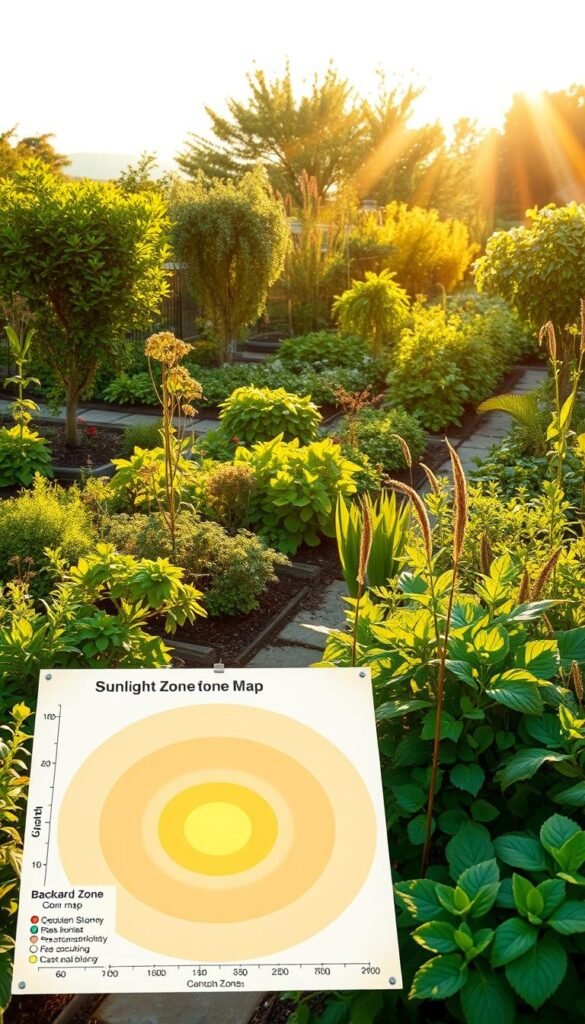
Transforming your outdoor space begins with smart preparation. Think of your yard as a blank canvas where every plant serves a purpose – beauty and bounty. Start by sketching a rough design blueprint to organize your ideas before digging begins.
Assess Your Backyard’s Potential
Grab graph paper and outline existing features like trees or patios. Note how much space each plant will need when fully grown. For example, berry bushes require 3-4 feet between them, while dwarf fruit trees need 8-10 feet. This prevents overcrowding and ensures healthy airflow.
Mapping Sunlight, Zones, and Space
Track how sunlight moves across your area throughout the day. South-facing spots often get the most light – perfect for sun-loving strawberries. Shady corners? Try mint or currants. Use the USDA Plant Hardiness Zone Map to pick plants suited to your climate.
| Plant Type | Sunlight Needs | Suitable Zones |
|---|---|---|
| Blueberries | 6-8 hours | 3-9 |
| Figs | Full sun | 7-10 |
| Herbs | 4-6 hours | 4-11 |
Watch for microclimates – a sunny wall might let you grow plants typically unsuited for your zone. Your gardening success starts with matching nature’s patterns to your edible design.
Designing an Efficient and Aesthetic Fruit Garden
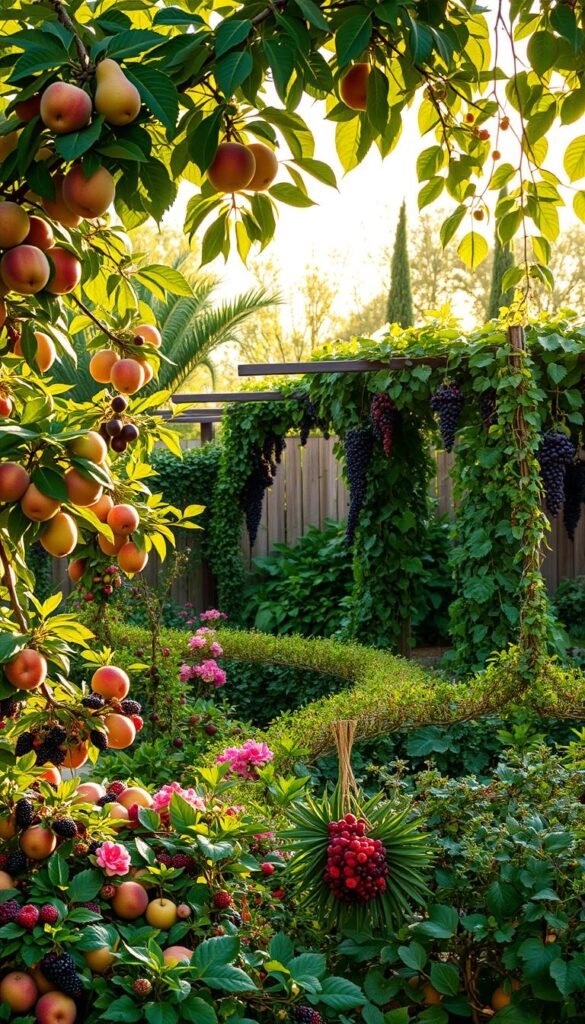
Crafting a space that feeds both eyes and appetite requires smart layering. Think vertical design elements combined with edible ground-level textures. This approach maximizes productivity while creating natural visual flow.
Strategic Placement of Productive Plants
Start with dwarf apple or pear trees as your tallest layer. Underplant them with sun-loving berries like raspberries that thrive in dappled shade. Blueberry bushes work beautifully as living fences, offering spring blooms and summer snacks.
Train vines along fences or arbors for vertical interest. Thornless blackberries add texture with their arching canes, while kiwi plants provide tropical-looking foliage. These climbers turn unused airspace into snack stations.
Edible Carpeting for Bare Soil
Swap mulch with strawberry plants as a ground cover that yields sweet rewards. Their white flowers and red fruit create polka-dot charm between stepping stones. Creeping thyme makes another flavorful cover, releasing fragrance when brushed.
Mix leaf shapes and colors for depth – bronze-hued mint alongside silvery sage. This layering technique suppresses weeds while creating a tapestry of edible textures. Your design becomes both practical and painterly.
Implementing Your “Backyard Fruit Garden Makeover: Turning a Plain Yard into a Food Oasis”
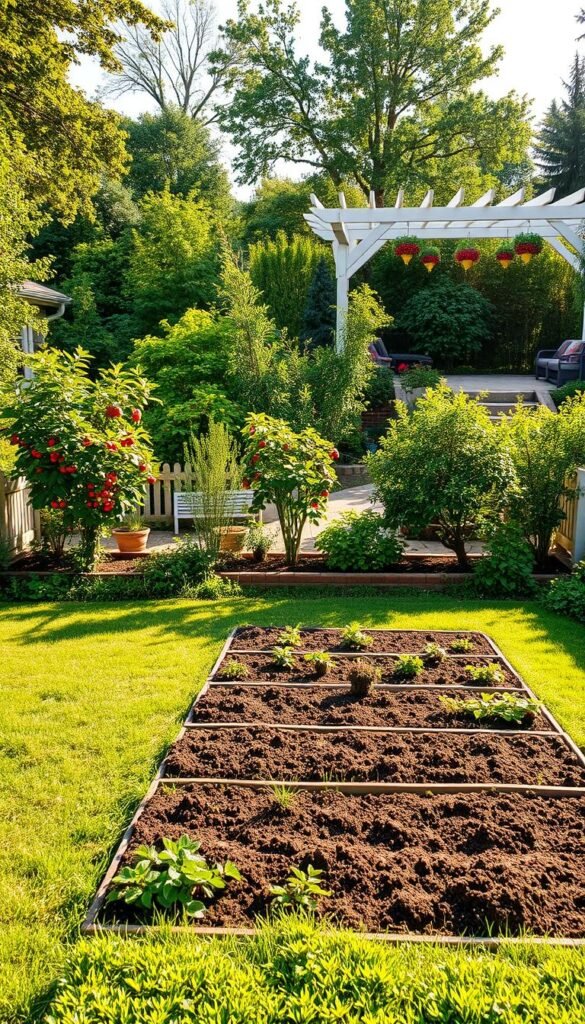
Creating your edible paradise unfolds like a good story—one chapter each season. This process rewards those who embrace gradual progress over instant perfection. Think of your space as a living project that improves with every growing cycle.
Step-by-Step Transformation Process
Begin with permanent features that shape your design. Install pathways and plant anchor trees first—these form your garden’s skeleton. In year two, add berry bushes or grapevines along fences. Ground covers like thyme or strawberries fill gaps in later seasons.
Perennials need time to work their magic. Blueberry bushes might take three years to produce heavily, while asparagus beds reward patience with decades of harvests. Track growth patterns to see what thrives in your microclimates.
Spread costs and effort by tackling one zone annually. Maybe focus on the sunny south side this year, then address shaded areas next spring. This way, you’ll refine techniques without burnout.
Celebrate each milestone—your first ripe fig or buzzing pollinator visit. These moments prove your steps are building something lasting. Remember: every great food forest started with a single plant.
Selecting Fruit Trees, Nut Trees, and Citrus Options
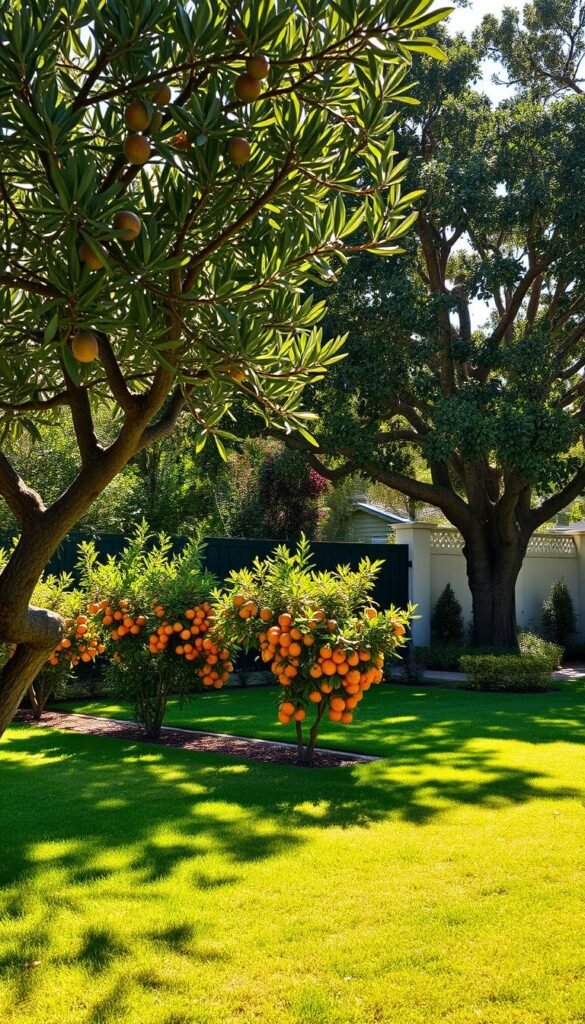
Choosing the right trees transforms your landscape into a living pantry. Whether you crave summer peaches or winter citrus, your climate holds the key to success. From compact dwarf varieties to sprawling nut bearers, each tree type offers unique benefits that blend beauty with productivity.
Climate Compatibility and Space Savers
Your location dictates which trees will thrive. Cold-hardy apples and pears excel in northern zones, while figs and persimmons soak up southern heat. Dwarf citrus varieties let even patio gardeners grow lemons or limes in containers.
| Tree Type | Ideal Climate | Spacing Needs | Yield Timeline |
|---|---|---|---|
| Apple | Zones 3-8 | 15-20 ft | 3-5 years |
| Fig | Zones 7-10 | 10-15 ft | 2-3 years |
| Pecan | Zones 6-9 | 60-80 ft | 6-10 years |
| Almond | Zones 7-9 | 15-20 ft | 3-4 years |
| Lemon | Zones 9-11 | 8-12 ft | 1-2 years |
Strategic Positioning for Abundance
Place taller nut trees like walnuts on your property’s north side to avoid shading smaller plants. Semi-dwarf fruit trees fit neatly along sunny borders, creating edible screens. Proper spacing prevents disease and lets sunlight reach lower-growing companions.
Citrus positioned near south-facing walls absorbs reflected heat, boosting growth in cooler areas. This smart placement creates microclimates that stretch your growing potential. Your tree choices become the framework for a layered, productive ecosystem.
Building a Perennial Food Forest System
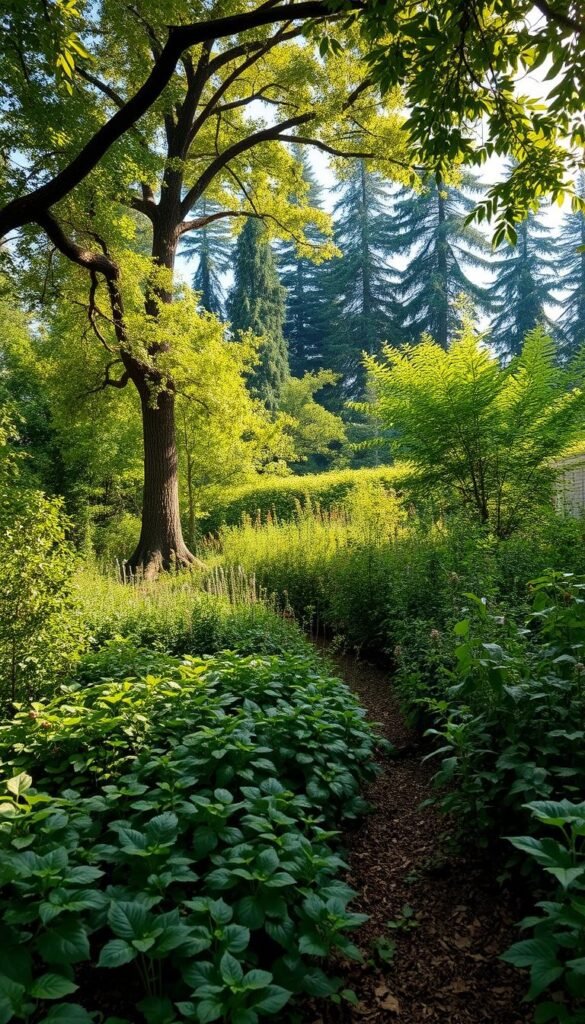
Nature’s blueprint offers the perfect model for sustainable food production. A food forest layers edible plants like a wild ecosystem, combining beauty with abundance. Unlike traditional gardens, this living system grows more resilient each year while needing less work from you.
Understanding the Layers: Canopy to Rhizosphere
Seven natural tiers create a thriving system. Tall nut trees form the canopy, sheltering smaller fruit trees below. Berry bushes and herbs fill the middle layers, while root crops and mushrooms work underground. This design:
- Protects plants from harsh weather
- Maximizes every inch of growing space
- Encourages natural pest control
Climbing vines like grapes use vertical supports, while strawberries spread as edible ground cover. Each layer supports others – mint repels pests for nearby fruit trees, while comfrey leaves feed the soil.
Integrating Perennial Edibles for Longevity
Choose perennials that thrive in your climate for decades of harvests. Asparagus beds produce for 20+ years, and blueberry bushes yield more fruit as they age. These plants:
- Require no annual replanting
- Develop deep root systems that survive droughts
- Attract beneficial insects year-round
Mix nitrogen-fixing plants like clover with heavy feeders like apples. As your food forest matures, it becomes a self-fertilizing network. You’ll spend less time weeding and watering, and more time harvesting.
Incorporating Edible Ground Covers and Herbs
Your landscape’s forgotten corners hold untapped potential. By layering edible plants beneath trees and between pavers, you’ll transform bare soil into a living buffet. These multitasking ground covers and herbs beautify your space while delivering fresh flavors to your kitchen.
Maximizing Underutilized Space
Creeping thyme fills cracks in walkways with fragrant greenery. Wild leeks thrive under fruit trees, their slender leaves soaking up dappled sunlight. Sea kale’s blue-tinged foliage creates striking borders that double as salad ingredients.
| Plant | Sunlight Needs | Key Benefits |
|---|---|---|
| Creeping Thyme | Full sun | Pathway filler, pizza seasoning |
| Lemon Balm | Partial shade | Tea herb, mosquito repellent |
| Woodland Strawberry | Shade tolerant | Sweet berries, evergreen leaves |
Planting Aromatic and Medicinal Varieties
Rosemary’s pine-like scent deters pests while flavoring roasted veggies. Purple sage adds velvety texture to flower beds – rub its leaves to release stress-relieving oils. For less work, choose self-seeding herbs like oregano that return yearly without replanting.
Clusters of lavender near seating areas invite relaxation through their calming fragrance. Mint varieties spread vigorously, making them perfect for filling large ground areas quickly. Just plant them in containers to control their enthusiastic growth.
Eco-Friendly Garden Maintenance Tips
Healthy soil forms the foundation of a thriving edible landscape. By working with nature rather than against it, you’ll create a self-sustaining ecosystem that nourishes your plants and local wildlife. Let’s explore simple strategies to keep your space productive and chemical-free.
Utilizing Natural Mulch, Compost, and Inoculants
Transform yard waste into gold. Fallen leaves and grass clippings make excellent mulch that suppresses weeds while feeding earthworms. For best results, layer 3-4 inches around trees and shrubs, keeping it away from stems to prevent rot.
Boost soil health with mycorrhizal inoculants. These beneficial fungi form partnerships with plant roots, helping them absorb nutrients more efficiently. When planting new additions, dust their roots with this powdery ally for faster establishment.
Encouraging Beneficial Insects and Pollinators
Attract nature’s pest control squad by planting nectar-rich blooms. Marigolds repel harmful nematodes, while cosmos lure ladybugs that devour aphids. Here’s a quick guide to insect-friendly options:
| Plant | Benefit |
|---|---|
| Alyssum | Attracts hoverflies |
| Echinacea | Feeds butterflies |
| Thyme | Shelters ground beetles |
Avoid pesticides to protect these tiny helpers. Even organic gardening basics emphasize letting nature balance itself through biodiversity.
Seasonal Care for a Thriving Garden
Spring calls for refreshing mulch layers and planting warm-season companions like basil. Summer demands consistent watering – use soaker hoses to conserve resources. Come fall, leave some leaf litter as winter habitat for beneficial insects.
Young trees need extra attention. Clear grass within 3 feet of their base to prevent competition. Wrap trunks in winter to deter rodents. With each season, your gardening practices become more intuitive and effective.
Adapting Your Garden for Varied Climates and Seasons
Your edible landscape becomes most valuable when it thrives through every weather twist. Start by choosing climate-smart selections – native berries that shrug off local pests or citrus grafted onto cold-hardy rootstocks. Pair these with seasonal stars like figs that sweeten in summer heat or kale that tastes better after frost.
Create microclimates using nature’s patterns. Plant drought-tolerant trees near sun-baked walls to shield tender herbs. Use deciduous varieties to let winter sunlight warm stone paths that radiate heat at night. These subtle adjustments help stretch your growing season naturally.
Protect plants without chemicals when extremes hit. Floating row covers guard against late frosts, while shade cloth prevents leaf scorch during heatwaves. Mulch deeply before droughts and switch to fast-draining soils in rainy regions. Your adaptive approach turns challenges into opportunities for learning.
With smart planning, your space becomes a resilient producer. You’ll harvest crisp apples after chilly winters and plump grapes following humid summers. Each season’s lessons make your edible ecosystem more attuned to nature’s rhythms – and better at feeding your family year-round.

